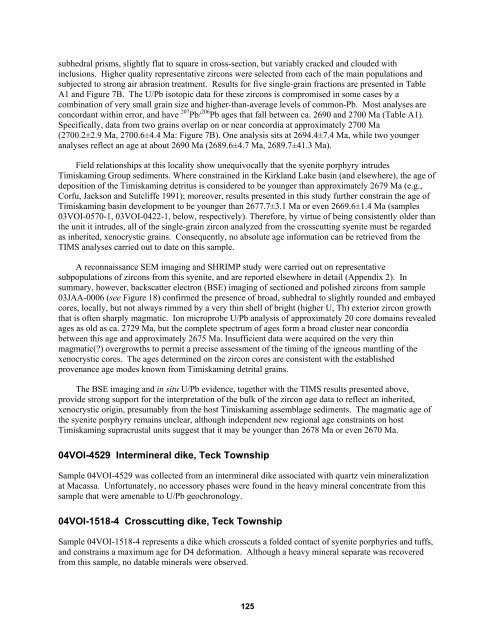Overview of Results from the Greenstone ... - Geology Ontario
Overview of Results from the Greenstone ... - Geology Ontario
Overview of Results from the Greenstone ... - Geology Ontario
You also want an ePaper? Increase the reach of your titles
YUMPU automatically turns print PDFs into web optimized ePapers that Google loves.
subhedral prisms, slightly flat to square in cross-section, but variably cracked and clouded with<br />
inclusions. Higher quality representative zircons were selected <strong>from</strong> each <strong>of</strong> <strong>the</strong> main populations and<br />
subjected to strong air abrasion treatment. <strong>Results</strong> for five single-grain fractions are presented in Table<br />
A1 and Figure 7B. The U/Pb isotopic data for <strong>the</strong>se zircons is compromised in some cases by a<br />
combination <strong>of</strong> very small grain size and higher-than-average levels <strong>of</strong> common-Pb. Most analyses are<br />
concordant within error, and have 207 Pb/ 206 Pb ages that fall between ca. 2690 and 2700 Ma (Table A1).<br />
Specifically, data <strong>from</strong> two grains overlap on or near concordia at approximately 2700 Ma<br />
(2700.2±2.9 Ma, 2700.6±4.4 Ma: Figure 7B). One analysis sits at 2694.4±7.4 Ma, while two younger<br />
analyses reflect an age at about 2690 Ma (2689.6±4.7 Ma, 2689.7±41.3 Ma).<br />
Field relationships at this locality show unequivocally that <strong>the</strong> syenite porphyry intrudes<br />
Timiskaming Group sediments. Where constrained in <strong>the</strong> Kirkland Lake basin (and elsewhere), <strong>the</strong> age <strong>of</strong><br />
deposition <strong>of</strong> <strong>the</strong> Timiskaming detritus is considered to be younger than approximately 2679 Ma (e.g.,<br />
Corfu, Jackson and Sutcliffe 1991); moreover, results presented in this study fur<strong>the</strong>r constrain <strong>the</strong> age <strong>of</strong><br />
Timiskaming basin development to be younger than 2677.7±3.1 Ma or even 2669.6±1.4 Ma (samples<br />
03VOI-0570-1, 03VOI-0422-1, below, respectively). Therefore, by virtue <strong>of</strong> being consistently older than<br />
<strong>the</strong> unit it intrudes, all <strong>of</strong> <strong>the</strong> single-grain zircon analyzed <strong>from</strong> <strong>the</strong> crosscutting syenite must be regarded<br />
as inherited, xenocrystic grains. Consequently, no absolute age information can be retrieved <strong>from</strong> <strong>the</strong><br />
TIMS analyses carried out to date on this sample.<br />
A reconnaissance SEM imaging and SHRIMP study were carried out on representative<br />
subpopulations <strong>of</strong> zircons <strong>from</strong> this syenite, and are reported elsewhere in detail (Appendix 2). In<br />
summary, however, backscatter electron (BSE) imaging <strong>of</strong> sectioned and polished zircons <strong>from</strong> sample<br />
03JAA-0006 (see Figure 18) confirmed <strong>the</strong> presence <strong>of</strong> broad, subhedral to slightly rounded and embayed<br />
cores, locally, but not always rimmed by a very thin shell <strong>of</strong> bright (higher U, Th) exterior zircon growth<br />
that is <strong>of</strong>ten sharply magmatic. Ion microprobe U/Pb analysis <strong>of</strong> approximately 20 core domains revealed<br />
ages as old as ca. 2729 Ma, but <strong>the</strong> complete spectrum <strong>of</strong> ages form a broad cluster near concordia<br />
between this age and approximately 2675 Ma. Insufficient data were acquired on <strong>the</strong> very thin<br />
magmatic(?) overgrowths to permit a precise assessment <strong>of</strong> <strong>the</strong> timing <strong>of</strong> <strong>the</strong> igneous mantling <strong>of</strong> <strong>the</strong><br />
xenocrystic cores. The ages determined on <strong>the</strong> zircon cores are consistent with <strong>the</strong> established<br />
provenance age modes known <strong>from</strong> Timiskaming detrital grains.<br />
The BSE imaging and in situ U/Pb evidence, toge<strong>the</strong>r with <strong>the</strong> TIMS results presented above,<br />
provide strong support for <strong>the</strong> interpretation <strong>of</strong> <strong>the</strong> bulk <strong>of</strong> <strong>the</strong> zircon age data to reflect an inherited,<br />
xenocrystic origin, presumably <strong>from</strong> <strong>the</strong> host Timiskaming assemblage sediments. The magmatic age <strong>of</strong><br />
<strong>the</strong> syenite porphyry remains unclear, although independent new regional age constraints on host<br />
Timiskaming supracrustal units suggest that it may be younger than 2678 Ma or even 2670 Ma.<br />
04VOI-4529 Intermineral dike, Teck Township<br />
Sample 04VOI-4529 was collected <strong>from</strong> an intermineral dike associated with quartz vein mineralization<br />
at Macassa. Unfortunately, no accessory phases were found in <strong>the</strong> heavy mineral concentrate <strong>from</strong> this<br />
sample that were amenable to U/Pb geochronology.<br />
04VOI-1518-4 Crosscutting dike, Teck Township<br />
Sample 04VOI-1518-4 represents a dike which crosscuts a folded contact <strong>of</strong> syenite porphyries and tuffs,<br />
and constrains a maximum age for D4 deformation. Although a heavy mineral separate was recovered<br />
<strong>from</strong> this sample, no datable minerals were observed.<br />
125

















